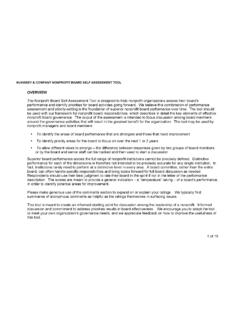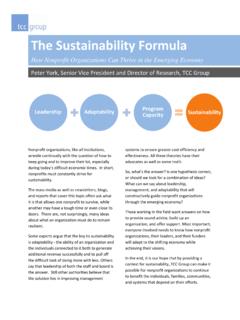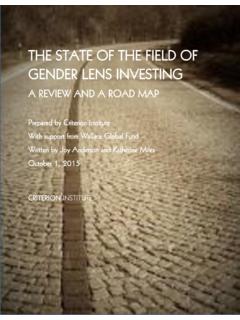Transcription of THE BALANCED SCORECARD METHOD: FROM …
1 IntroductionBalanced SCORECARD is a management system that enables organizations to translate the vision and strategy into action. This system provides feedback on internal business processes and external outco-mes to continually improve organizational perfor-mance and results. Robert Kaplan and David Nor-ton created the BALANCED SCORECARD approach in the early 1990s. Most traditional management systems focus on the financial performance of an organiza-tion. According to those who support the BALANCED SCORECARD , the financial approach is unbalanced and has major limitations: 1. Financial data typically reflect an organiza-tion s past performance. Therefore, they may not accurately represent the current state of the organi-zation or what is likely to happen to the organization in the BALANCED SCORECARD METHOD: FROM THEORY TO PRACTICE Margarita I ORAIT Mykolas Romeris Universitety Ateities str.
2 20, LT 08303 Vilnius, Lithuania El. pa tas Abstract. Performance management has become a legislative requirement for the private and local sectors. Unfortunately, not many tools exist to measure and monitor public and private service delivery effectively. Managers require accurate information to ensure that their decisions are not based on emotions and assumptions but that the information with regard to service delivery is accurate and relevant. In modern business models, intangible assets such as employee skills and knowledge levels, customer and supplier relationships, and an innovative culture are critical in providing the much-needed cutting-edge to the organisation. This is where tools like the BALANCED SCORECARD method hold relevance for the enterprise.
3 Developed by Robert Kaplan and David Norton, the BALANCED SCORECARD method translates an organisation s strategy into performance objectives, measures, targets and initiatives. It is based on four BALANCED perspectives, and links them together with the concept of cause and effect. A proper BALANCED SCORECARD can predict the effectiveness of an organisation s strategy through a series of linked performance measures based on four perspectives including finance, customers, internal processes, employee learning and Classification: G390, : BALANCED SCORECARD , strategy maps, performance measurementReik miniai od iai: subalansuoti rodikliai, strateginiai em lapiai, veiklos i It is not uncommon for the current market va-lue of an organization to exceed the market value of its assets.
4 There are financial ratios that reflect the value of a company s assets relative to its market value. The difference between the market value of an organization and the current market value of the organization s assets is often referred to as intangible financial measures do not cover the-se intangible main purpose of this article is to analyse the BALANCED SCORECARD method theory and practice. The article seeks to analyse the origins of the BALANCED SCORECARD method, evaluate this method in private and public sectors, and to analyse the strategy map-ping process. ISSN 1822-8011 (print)ISSN 1822-8038 (online)INTELEKTIN EKONOMIKAINTELLECTUAL ECONOMICS 2008, No. 1(3), p. 18 2819 The BALANCED SCORECARD Method: from Theory to Practice 1.
5 Origins of the Balance SCORECARD MethodThe BALANCED SCORECARD was developed by Robert Kaplan and David Norton (1992). In 1990, Kaplan and Norton led a research study of a lot of companies with the purpose of exploring the new methods of performance measurement. The impor-tance of the study was a growing belief that finan-cial measures of performance were ineffective for the modern business enterprise. Representatives of the study companies, along with Kaplan and Norton, were convinced that reliance on financial measures of performance had an affect on their ability to cre-ate value. The group discussed a number of possible alternatives but settled on the idea of a SCORECARD , featuring performance measures capturing activities from throughout the organization customer issues, internal business processes, employee activities, and of course shareholder concerns.
6 Kaplan and Norton introduced the new tool the BALANCED SCORECARD and later summarized the concept in the first of three Harvard Business Review articles, The BALANCED SCORECARD Measures That Drive Performance. The BALANCED SCORECARD has been translated and effectively implemented in both the nonprofit and public sectors. Success stories are beginning to accu-mulate and studies suggest the BALANCED SCORECARD is of great benefit to both these organization is a BALANCED SCORECARD ? The BALANCED SCORECARD can be understood as a management sys-tem, which is structured according to the logic of the management circle ( plan-do-check-act ). The Ba-lanced SCORECARD resembles a typical management fashion.
7 For instance, Van den Heuvel & Broekman wrote that a self-respecting organization apparently can no longer do without the BALANCED SCORECARD (1998) and Hers (1998) pointed to an abundance of congresses, seminars and publications on the theme. In crescendo, commentators spoke of a real trend (Koning & Conijn, 1997), a fad-like impression (Du M e, 1996) and a true hype (Hers, 1998). Such statements suggest that the BALANCED SCORECARD has become popular and brought about many changes in a variety of organizations. If the quoted authors are right, the BALANCED SCORECARD even resembles a typi-cal management and Norton position the BALANCED Sco-recard as a tool for organisations to manage the de-mands of relevant stakeholders and to translate stra-tegies into action ( from strategy to action ).
8 Possi-ble stakeholders that are strategically relevant could be shareholders, customers or employees. Their de-mands are integrated into core management of com-panies within a financial , customer or learning or process perspective (see Figure 1 below). So, the frame of the BALANCED SCORECARD consists of four perspectives (see Figure 1). Each perspective consists of relevant strategic goals, indicators and measures to achieve them. One should emphasize the fact that the concept remains open for integrating further relevant stakeholders or perspectives, an environmental perspective (Kaplan and Norton 1997, pp. 33). When conceiving the BSC, Kaplan and Norton, maintained that companies lack sophisticated tools for the mana-gement of intangible or qualitative assets ( cus-tomer satisfaction, processes quality, infrastructures, know-how).
9 Intangible assets, however, seem vital in order to stay competitive in the future. So, the Balan-ced SCORECARD provides enablers that focus on the achievement of strategic goals in the future (leading indicators) as well as results (lagging indicators) to depict the effectiveness and efficiency of measures in the past. Strategies can be usually interpreted as a set of hypotheses of causes and effects. So within a BSC the relevant goals and corresponding indica-tors are linked to each other revealing this structure of causal relationships. Such relationships are both relevant within each perspective and also between them. Objectives of the learning perspective, for instance, serve as enablers for the achievement of goals of the other overarching perspectives ( customers, finance).
10 The BSC was originally created primarily as a measurement system and as an answer to a criti-cism concerning the unilateral measurement of the performance ability of a company. It was organised through four different perspectives: The financial perspective: to succeed finan-cially, how should we appear to our share-holders? Examples of this perspective in-clude financial ratios and various cash flow measures. The customer perspective: to achieve our vision, how should we appear to our custo-mers? Examples of this perspective include the amount of time spent on customer calls and customer survey data. The internal perspective: to satisfy our share-holders and customers, what business proces-ses must we excel at?





